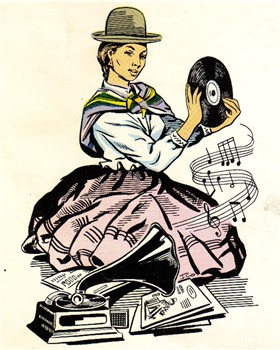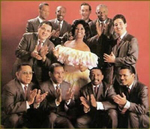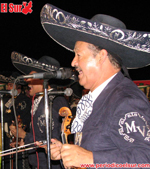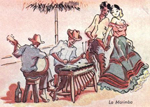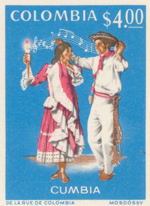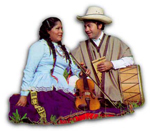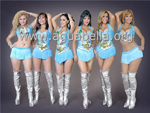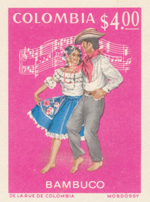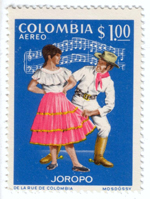|
|
Common to many areas |
balada |
Latin Adult Contemporary. Angela Carrasco is from the Dominican Republic. Daniela Romo is Mexican |
|
bolero |
Popular in Mexico, Central America, the Caribbean, and criollo areas of the Andean countries. Los Embajadores is an Ecuadorian trio. "Sombras" is originally a tango, this theme exists in many local versions, for instance in Ecuador by Benitez y Valencia. Read more about the bolero: http://en.wikipedia.org/wiki/Bolero For bolero lyrics, see: http://www.morellajimenez.com.do/letras.htm |
|
|
pasodoble |
Of Spanish heritage, the pasodoble is heard as in intro or as a change of mood in dance parties in countries which have one thing in common, they allow bullfights (in Southern South America bullfights are now allowed). |
|
|
tropical
|
In Venezuela, Colombia, Ecuador, Peru and Bolivia also called tropical andina; in Venezuela, tropical tecnopop.
This Colombian version of "La Colegiala" is from the mid-80's. The original version was composed in Perù and first launched in 1975. Arguably created by Argentinian Ricky Maravilla, a
representative of the "Movida tropical" movement, this theme is also
wellknown in Chile. See also under cumbia |
|
|
rock / rap |
Locally produced in certain metropolitan areas. "Qué pasa" is a Venezuelan group. The theme was later recorded by Panamanian rap specialist El General. |
|
|
aguinaldo
|
Various MIDI-themes and explanations at: http://www.musicadepuertorico.com/english/aguinaldos.htm
Various versions of a Puertorican aguinaldo on the
cuatro. The website http://www.sensemaya.net/LaParranda.pdf contains a thesis on Puerto Rico's Christmas serenading tradition. |
|
|
salsa
|
Modernized way of playing Afro-Cuban music featuring reinforced brass and percussion sections.
The Grupo Niche selections are examples of the "Cali Sound". "La negra no quiere" is from 1982 or so. Celia Cruz (1925-2003) was called "la Reina de la Salsa", but the nickname she preferred was "la Guarachera de Cuba". Read about salsa: http://en.wikipedia.org/wiki/Salsa_(dance) Oscar de León is one of the foremost Venezuelan soneros. See article "Soneros: A Dying Breed": http://www.descarga.com/cgi-bin/db/archives/Article14 Vocabulary heard in salsa tunes: https://en.wikipedia.org/wiki/Salsa_dance_(Cuban_style) |
|
|
Mexico and Central America |
corrido (ranchera)
|
corrido is also known as ranchera. The second example is a ranchera used in
serenatas for birthday greetings alongside with the well-known
theme "Las mañanitas".
|
|
tejano
|
tejano is also known as tex-mex. The late Selena is perhaps the most well known of all tejano artists. Also known as bandas, groups of 10-20 musicians, playing bass-based traditional music, including waltzes, cumbias, marches |
|
|
son huasteco
|
Traditional styles in Mexico, often played by mariachi
orchestras,
jarocho indicates Vera Cruz as the origin. Many examples of huapango tamulipeco, huapango huasteco and huapango veracruzano in YouTube. |
|
|
son guatemalteco
|
Featuring the marimba, the national instrument of Guatemala. In
Costa Rica, as well as in Guatemala and Chiapas, México,
the marimba is cherished instrument.
|
|
|
punto guanacasteco
|
Costa Rican audio samples : |
|
|
tonada |
Costa Rica, Guatemala, Honduras, Nicaragua and El Salvador. |
|
|
Caribbean Basin and Surrounding Areas |
danzón |
Old-time formal Cuban dance music. Played on the Sunday evening birthday greetings show on Radio Rebelde (5025 kHz and many MW frequencies). |
|
son |
The son originated in Cuba, and is now widely heard all over Latin America. The "Trío Matamoros" sample is a classic; there are dozens of salsa arrangements of this tune. |
|
|
guajira |
Cuban Country music. The single most popular example is "Guajira Guantanamera". Many guajiras were "rediscovered" by Buena Vista Social Club. |
|
|
rumba |
Afro-Cuban percussion and vocal style. See Décima and Rumba: "Iberian formalism in the heart of
Afro Cuban Song" at |
|
|
charanga |
Cuban style with violins and flute. This sample is a "classic". |
|
|
pachanga |
Created at the outset of the 1950's in Cuba, coinciding with the political overturn of Cuba, the pachanga in the USA was confusingly named charanga. See http://en.wikipedia.org/wiki/Pachanga In this song "La pachanga se baila así", Joe Quijano explains that the pachanga is the dance, and charanga is the band. |
|
|
bugalú, boogaloo |
Fusion of many Cuban styles with American R&B and soul, arguably first Latin rhythm created in New York. | |
|
guaguancó |
Cuban. The title translates to "The station jumble" (referring to the overcrowding of the broadcasting dial). Vocabulary heard in salsa tunes: https://en.wikipedia.org/wiki/Salsa_dance_%28Cuban_style%29 |
|
|
mambo |
Cuban big-band style. |
|
|
cha cha chá |
A Cuban "classic". |
|
|
bomba y plena |
A Puerto Rican musical style. http://www.puertoritmo.com/ explains in detail rhythms sprung from Puertorican soil like the "bomba" and the "plena". |
|
|
merengue |
From the Dominican Republic. "Compadre Pedro Juan" is often referred to as the second national anthem of the Dominican Republic, a beautiful rendering of a "classic". Tambora y Güira is a page devoted to music gennes of the Dominican Republic: http://www.mindspring.com/%7Eadiascar/musica/index-e.htm |
|
|
bachata |
Sensual midtempo acoustic/electric style from the Dominican Republic. |
|
|
cumbia
|
Originating in Colombia and Panamá, this dance is kind of lingua franca to Spanish speaking people in the Western hemisphere. cumbia is popular in Colombia and Panama, with regional variants in Peru, Bolivia, Central America and Mexico. The Mexican and Central American cumbia is faster than its Colombian counterpart. In a special Millennium Poll conducted by Colombia´s RCN Radio y TV, "La pollera colorá" was selected as the 5th most popular Colombian tune of the 20th Century. "Dancing through Colombia" was aired on BBC World Service in May 1993. See about cumbia sonidera at: http://cumbiavancouver.blogspot.com/2011/05/what-is-cumbia-sonidera-and.html The Peruvian group Los Walkers is from Huánuco. |
|
|
porro |
Mainstream dance music in Colombia, also known as tropical and sometimes raspa. The two selections belong to the "oldies"genre and will be heard mainly for Christmas. The Colombian gaita sounds rather like a clarinet, which Lucho Bermúdez used to play himself. |
|
|
vallenato |
Colombian "Country & Western". Sabanero refers to the area west of the Magdalena river, i.e. not originating from Valledupar, which is the cradle of the vallenato.
For history of the vallenato, see: http://en.wikipedia.org/wiki/Vallenato |
|
|
tamborito |
Traditional from Panamá |
|
|
reggae, reggatón |
Originally from Jamaica and Panamá, now popular throughout the Caribbean Islands. Marcos Malory is from Puerto Rico.. |
|
|
soca
|
Evolved from Trinidadian calypso,
now popular in many parts of the Caribbean. |
|
|
zouk |
Popular in Frenchspeaking areas of the Antilles. The title of the song translates to "Zouk is the only medicine we have". |
|
|
hip hop / dance |
Heard in Venezuela, Panama, Caribbean basin and Peruvian jungle area |
|
|
punta |
Popular along the Caribbean coastline of Central America, especially Honduras |
|
|
Andean Regions of Ecuador, Peru & Bolivia |
pasillo |
The Ecuadorian pasillo is very popular in northern Peru. "Latidos" is an extremely typical
example of this style. |
|
danzante, pasacalle |
Ecuadorian. Held as kind of a second national anthem of Ecuador. "El chula quiteño" exists
in countless vocal and instrumental versions. |
|
|
albazo, tonada |
Ecuadorian. Here is a recording
from Radio Runacunápac Yachana, in Ecuador, on 2967.7
kHz, dated Jan 17 1993. "La música es la expresión de sentimiento y valentía: el danzante... el aire típico... el pasacalle... la tonada... el pasillo... el sanjuanito... el capishca... el yaraví... el cachullapi... el albazo... Estos son los ritmos que vibran en el fondo de cada ser humano. Usted sintoniza Radio El Saber del Hombre". |
|
|
sanjuanito, sanjuanero |
The two samples are Ecuadorian; this style is also found in northern Peru.
|
|
|
huayno |
This is a music style typical of the Peruvian sierra.
The two Los Reales samples are from northern
Peru. The audio quality for these is as received from Radio Gotas
de Oro (now Radio Uno), in Chiclayo. Grupo Norte Potosí is a Bolivian charango group. The selection is the "anthem" of the town of Huancayo, Peru. Ernesto Sánchez Fajardo a.k.a. "El
Jilguero del Huascarán" has recorded several tunes which are heard
regularty on the air for certain festivities, for instance
Mother's Day. Scores of Peruvian music: http://www.musicaperuana.com (The Peruvian Musical Corner) |
|
|
huayño |
From Bolivia. |
|
|
huaylas |
Peruvian festive dance. |
|
|
yaravi
|
Popular in Ecuador, Peru, and Bolivia. Ecuatorian yaraví... Bolivian yaraví... "Rítmos sudamericanos" lists in alphabetical order almost all varieties of music to be heard in the Andean countries: http://www.pacoweb.net/index2.html |
|
|
chicha |
Modern urban Peruvian blend of huayno and
cumbia. |
|
|
tecno-cumbia |
|
|
|
lambada |
This is the original version, a Bolivian saya, rearranged in the early 80´s by the Peruvian group Cuarteto Continental and later presented internationally as "lambada" by the Brazilian group Kaoma, in an international lawsuit. Gonzalo and Ulises Hermoza a.k.a. Los K´jarkas, claimed and gained the authorship of the tune. Eveline Rocha claims that Llorando se fue is
actually a caporales,
not a saya. Visit her site for more on Bolivian folklore: http://www.bolivia.at |
|
|
Andean Valleys & Regions East of the Cordillera |
guabina, torbellino |
An old Colombian music style, seldom heard nowadays. |
|
pasillo |
Colombian brand of pasillo, rarely
heard in these days. |
|
|
bambuco |
Colombia and Western Venezuela. The sample is the signature tune for Ecos del Torbes (4980 kHz) in San Cristóbal, which was the Venezuelan flagship on the 60 meter band until the end of the 1990's. |
|
|
joropo |
From the plains (llanos) of Venezuela and Eastern Colombia, the joropo and the pasaje are referred to as música llanera.
The standard instrumental line-up arpa, cuatro y maracas. Search these words on Google images for pictures. |
|
|
pasaje |
Venezuela and Colombia. (There is an unrelated style called pasaje in Colombian vallenato). |
|
|
carrilera, guasca |
From Colombia, a local type of corrido (see under Mexico), also known as guasca. In the sample, a woman is desperately looking for her lover. She runs from one saloon to another to see if she can find him. If she does, she will see to it that he'll get a razor-blade scar on both cheeks. That will help him remember who he belongs to, the lyrics say... (The initial part of this story is readily to be heard on the sample.) |
|
|
taquirari
|
Watch live improvisation of Recuerdos, a tune made popular by Los Jairas, in a La Paz market at |
|
|
bailecito |
Bolivian, here featuring the charango instrument. |
|
|
Pacific Coastline of Peru |
marinera - resbalosa |
There are examples of the marinera limeña (from Lima) and marinera norteña (from Trujillo and Chiclayo), the huaylash, and many other styles at the home page of the musical groups Expresion Latina y Raices Peruanas.at: http://www.raicesperuanas.net/ |
|
vals criollo |
See:
http://www.sonicomusica.com/vallenatos/los-inquietos/cancion/despues-que-te-perdi/ |
|
|
Bolivia, Northern Chile, NW Argentina |
bailecito |
Bolivian music |
|
vidala |
From Argentina. vidala, zamba, and chacarera are called música de tierra adentro. |
|
|
zamba |
The zamba is at the core of Argentinian folklore. |
|
|
chacarera |
Argentinian. See also La Pagina del Folklore Argentino. |
|
|
cueca |
Heard in Argentina, Bolivia, and Chile.See: http://en.wikipedia.org/wiki/Music_of_Argentina Los Huasos Quincheros is a Chilean group. |
|
|
Paraguay & Argentine "Litoral" (Chaco, Corrientes, Entre Rios, Formosa, Misiones and Santa Fé) |
guarania |
|
| polka paraguaya | You may enjoy visiting the web site http://www.musicaparaguaya.org.py where there are many samples of Paraguayan music |
|
|
galopera |
Another style from Paraguay. |
|
|
chamamé |
From the province of Corrientes, Argentina. Also known as música correntina. |
|
|
River Plate Area |
candombe |
Candombe is a typical Afro-Uruguayan style from the "Rio de la Plata" (River Plate), and a living tradition. It also co-existed in Buenos Aires, Argentina, but in the XIX century and due to war and other factors the Afro-Argentinian community disappeared. The basic sound is the drum beating, without any other instrument, using three bass drums: bombo, the rhythmic repique, piano with a tenor sound, and chico for a high-pitched sound. This sample adds melody, choir and other
instruments. Candombe is now one of the basic
sounds for Uruguayan contemporary music, along with the murga. |
|
cumbia villera |
Contemporary blend of urban canción de protesta, punk and rock, from suburbs of Buenos Aires. |
|
|
milonga |
Argentina and Uruguay. |
|
|
tango |
Argentina and Uruguay. "El entrerriano" was arguably the first tango.
Lyrics, artists, history of the tango here: http://www.todotango.com/Spanish/Home.aspx |
|
|
Brazil |
sertaneja |
Sertaneja music in Brazil is what the vallenato is to Colombia and the ranchera is to Mexico, a Brazilian kind of Country & Western. |
|
samba |
The music of the Brazilian Carnaval, also known
as pagode. |
|
|
forró |
Especially popular in the Nordeste (north eastern Brazil). |
|
|
baião |
Luiz Gonzaga is known as "O Rei do baião", the King of Baião . |
|
|
axé |
Popular music of Salvador da Bahia. |
